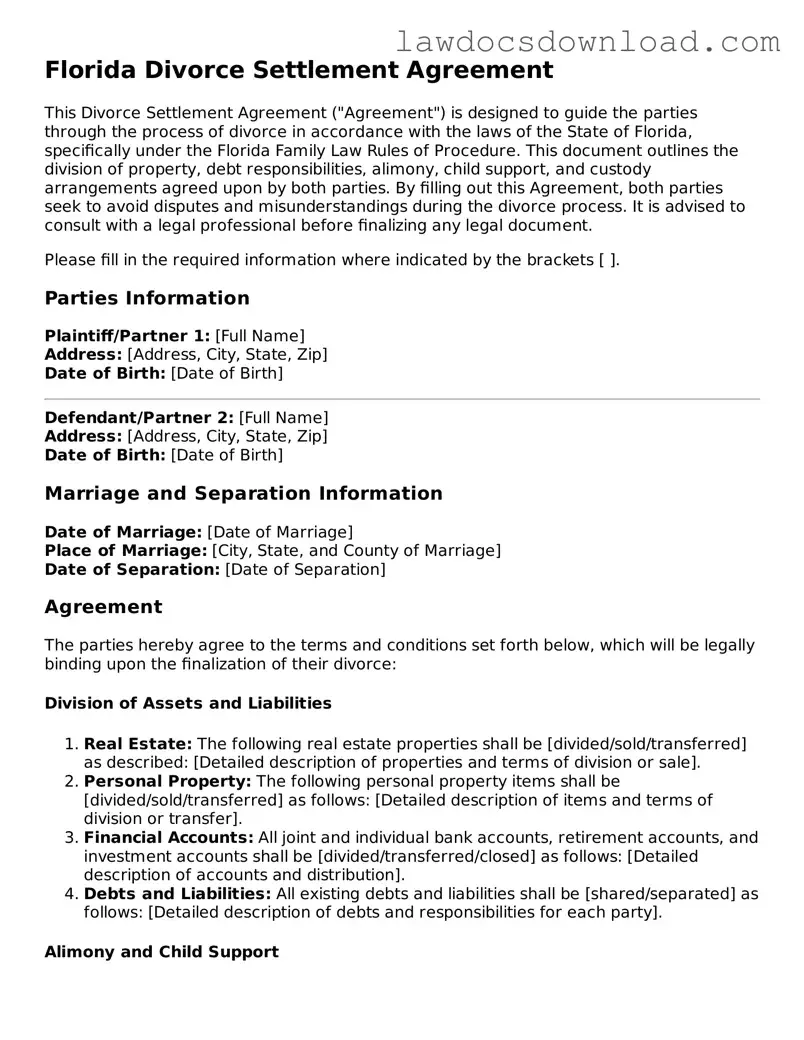Florida Divorce Settlement Agreement
This Divorce Settlement Agreement ("Agreement") is designed to guide the parties through the process of divorce in accordance with the laws of the State of Florida, specifically under the Florida Family Law Rules of Procedure. This document outlines the division of property, debt responsibilities, alimony, child support, and custody arrangements agreed upon by both parties. By filling out this Agreement, both parties seek to avoid disputes and misunderstandings during the divorce process. It is advised to consult with a legal professional before finalizing any legal document.
Please fill in the required information where indicated by the brackets [ ].
Parties Information
Plaintiff/Partner 1: [Full Name]
Address: [Address, City, State, Zip]
Date of Birth: [Date of Birth]
Defendant/Partner 2: [Full Name]
Address: [Address, City, State, Zip]
Date of Birth: [Date of Birth]
Marriage and Separation Information
Date of Marriage: [Date of Marriage]
Place of Marriage: [City, State, and County of Marriage]
Date of Separation: [Date of Separation]
Agreement
The parties hereby agree to the terms and conditions set forth below, which will be legally binding upon the finalization of their divorce:
Division of Assets and Liabilities
- Real Estate: The following real estate properties shall be [divided/sold/transferred] as described: [Detailed description of properties and terms of division or sale].
- Personal Property: The following personal property items shall be [divided/sold/transferred] as follows: [Detailed description of items and terms of division or transfer].
- Financial Accounts: All joint and individual bank accounts, retirement accounts, and investment accounts shall be [divided/transferred/closed] as follows: [Detailed description of accounts and distribution].
- Debts and Liabilities: All existing debts and liabilities shall be [shared/separated] as follows: [Detailed description of debts and responsibilities for each party].
Alimony and Child Support
The parties agree to the following terms regarding alimony and child support, in compliance with Florida Statutes:
- Alimony: [Name of the party] shall pay to [Name of the other party] the sum of [amount] per month as alimony for a period of [duration], starting from [start date] and ending on [end date].
- Child Support: In accordance with Florida Child Support Guidelines, [Name of the party] shall pay to [Name of the other party] the sum of [amount] per month as child support for the minor children, until each child reaches the age of 18, graduates from high school, or as otherwise agreed upon.
Child Custody and Visitation
The parties agree to the following arrangement regarding the custody and visitation rights of their minor children:
- Primary physical custody shall be awarded to [Name of the party], with the other party having rights to visitation as follows: [Detailed visitation schedule].
- Legal custody (decision-making authority) shall be [shared/jointly held/designated to one party], with both parties consulting each other on major decisions affecting the children’s welfare.
General Provisions
Both parties agree to disclose all assets and liabilities fully and accurately. Each party agrees to execute any documents necessary to effectuate the terms of this Agreement. This Agreement constitutes the entire agreement between the parties and supersedes any prior understandings or agreements. Any amendments to this Agreement must be in writing and signed by both parties.
Signatures
Partner 1 Signature: _______________________________ Date: [Date]
Partner 2 Signature: _______________________________ Date: [Date]
This document was prepared on [date] and is subject to review and changes as agreed upon by both parties or as required by the court.
